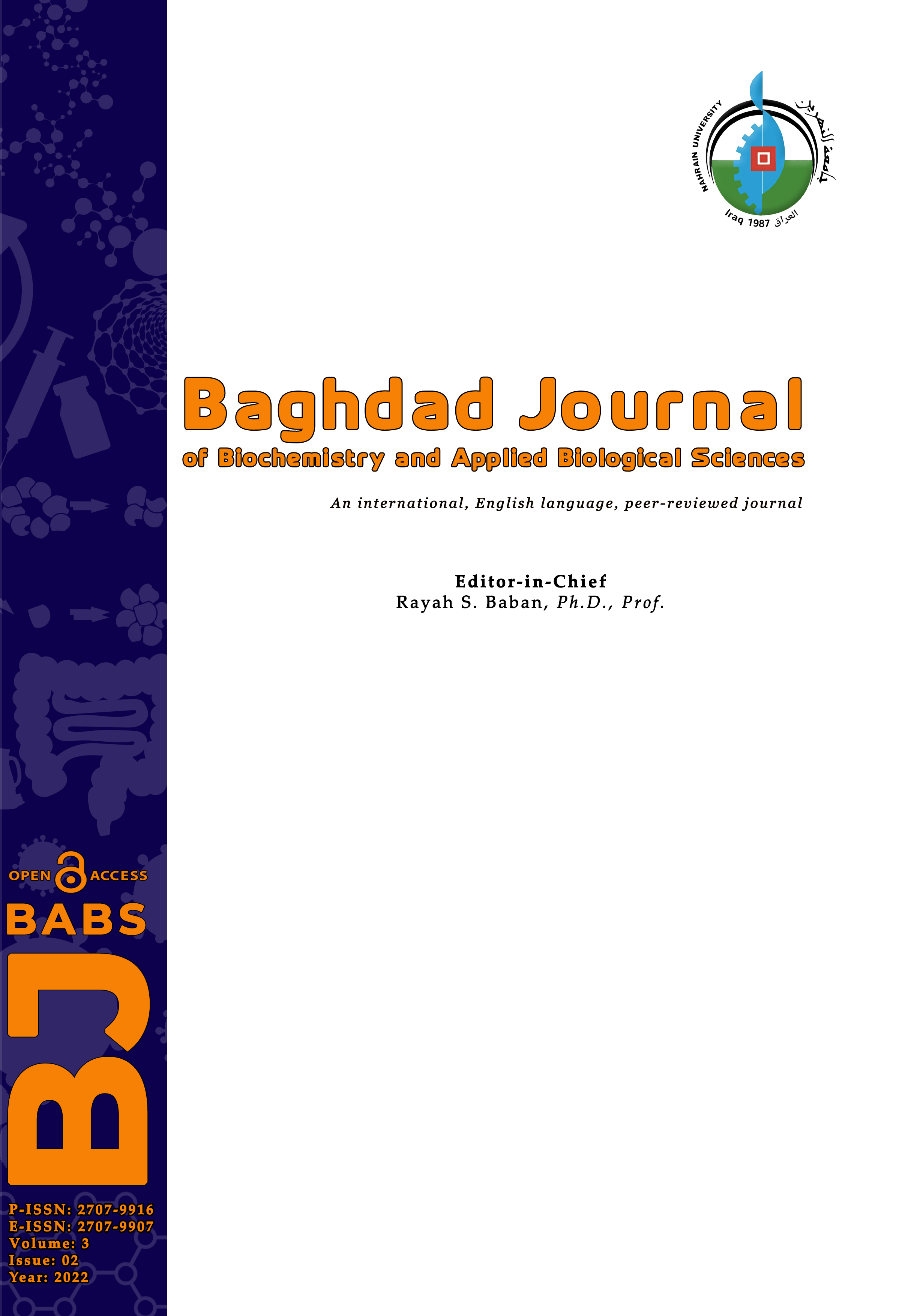Toxicity and anti-tumour activity of organotin (IV) compounds
DOI:
https://doi.org/10.47419/bjbabs.v3i02.131Keywords:
anti-tumor, biomedical, environment, organotin, toxicityAbstract
Organotins are widely described as anti-tumor, anti-inflammatory, anti-fungal, and antimicrobial agents. In addition to their use in biomedical fields, organotins are also used in agricultural and industrial applications. These materials are more toxic than inorganic cans, which are poorly absorbed and are excreted on the surface of the can, and cause toxicity to a variety of organisms and damage the environment.This review focuses on organotin’s toxicity and uses in biomedical fields.
Metrics
Downloads
References
A Attanzio, S Agostino, and R Busà. “Cytotoxic activity of organotin(IV) derivatives with triazolopyrimidine containing exocyclic oxygen atoms”. Molecules 25(4) (2020), pp. 859–859. DOI: 10.3390/molecules25040859.
A Graisa et al. “The organotin spectroscopic studies of hydroxamic as a ligand: A systematic review”. Al-Nahrain J Sci 25(1) (2022), pp. 14–23. DOI: 10.22401/ANJS.25.1.03.
Akanksha Kapila, Manpreet Kaur, and Harminder Kaur. “Organotin(IV) complexes of tridentate (O,N,O) Schiff base ligand: computational, spectroscopic and biological studies”. Mater Today Proceedings 40(S1) (2021), S120–S106.
Andrea Citarella et al. “Hydroxamic acid derivatives: From synthetic strategies to medicinal chemistry applications”. ACS Omega 34(6) (2020), pp. 21843–21849. DOI: 10.1021/acsomega.1c03628.
Angham G. Hadi et al. “Synthesis and biological activities of organotin (IV) carboxylates: A review”. Sys Rev Pharm 10(1) (2019), pp. 26–31. DOI: 10.5530/srp.2019.1.5.
Bertram Peters et al. “Current advances in tin cluster chemistry”. Chem Sci 11 (2020), pp. 16–26. DOI: 10.1039/C9SC04363B.
C E Carraher and M R Roner. “Organotin polyethers as biomaterials”. Materials (Basel) 2 (2009), pp. 1558–98. DOI: 10.3390/ma2041558.
C N Banti et al. “Anti-proliferative and antitumor activity of organotin(IV) compounds. An overview of the last decade and future perspectives”. J Inorg Biochem 194 (2019), pp. 114–152. DOI: 10.1016/j.jinorgbio.2019.02.003.
Claudia Pellerito et al. “Biological activity studies on organotin(IV)n+ complexes and parent compounds”. J Organomet Chem 691(8) (2006), pp. 1733–1747. DOI: 10.1016/j.jorganchem.2005.12.025.
D G Hayes. “Oils and Their Use Beyond the Food Industry”. In: Oil and Oilseed Processing. Ed. by T. Lafarga, G. Bobo, and I. Aguiló-Aguayo. Wiley, 2021, pp. 119–148. DOI: 10.1002/9781119575313.ch7.
D Mathew and S Sujatha. “Interactions of porphyrins with DNA: A review focusing recent advances in chemical modifications on porphyrins as artificial nucleases”. J Inorg Biochem 219 (2021), pp. 111434–111434. DOI: 10.1016/j.jinorgbio.2021.111434.
Duaa Ghazi, Zahraa Rasheed, and Emad Yousif. “A review of organotin compounds: Chemistry and applications”. Arch Org Inorg Chem Sci 33(3) (2018), pp. 344–352. DOI: 10.32474/AOICS.2018.03.000161.
E S Burkett and T A Siddiquee. “Coordination Nature of 4-Mercaptoaniline to Sn(II) Ion: Formation of a One Dimensional Coordination Polymer and Its Decomposition to a Mono Nuclear Sn(IV) Complex”. Inorganics 2(4) (2014), pp. 652–659.
E W Neuse. “Macromolecular ferrocene compounds as cancer drug models”. J Inorg Organomet Polym 15 (2005), pp. 3–31. DOI: 10.1007/s10904-004-2371-9.
F N Haezam et al. “Synthesis and cytotoxic activity of organotin(IV) diallyldithiocarbamate compounds as anticancer agent towards colon adenocarcinoma cells (HT-29)”. Saudi J Biol Sci 28(5) (2021), pp. 3160–3168. DOI: 10.1016/j.sjbs.2021.02.060.
G Gasser, I Ott, and N Metzler-Nolte. “Organometallic anticancer compounds”. J Med Chem 54(1) (2011), pp. 3–25. DOI: 10.1021/jm100020w.
K Alibek et al. “Role of viruses in the development of breast cancer”. Infect Agent Cancer 8 (2013), pp. 32–32. DOI: 10.1186/1750-9378-8-32.
M A Alam. “Methods for hydroxamic acid synthesis”. Curr Org Chem 23(9) (2019), pp. 978–993. DOI: 10.2174/1385272823666190424142821.
M Bouché et al. “Recent advances in iron-complexes as drug candidates for cancer therapy: reactivity, mechanism of action and metabolites”. Dalton Transactions 49(33) (2003), pp. 11451–11466. DOI: 10.1039/d0dt02135k.
M Coluccia and G Natile. “Trans-platinum complexes in cancer therapy”. Anticancer Agents Med Chem 7(1) (2007), pp. 111–123. DOI: 10.2174/187152007779314080.
M Jaishankar et al. “Toxicity, mechanism and health effects of some heavy metals”. Interdiscip Toxicol 7(2) (2014), pp. 60–72. DOI: 10.2478/intox-2014-0009.
Muhammad Sirajuddin et al. “Organotin(iv) carboxylate derivatives as a new addition to anticancer and antileishmanial agents: design, physicochemical characterization and interaction with Salmon sperm DNA”. RSC Adv 101(4) (2014), pp. 57505–57505. DOI: 10.1039/C4RA10487K.
Prithvi Moharana, Deblina Ghosh, and Priyankar Paira. “Drive to organoruthenium and organoiridium complexes from organoplatinum: Next-generation anticancer metallotherapeutics”. Inorg Chem Comm 124 (2021), pp. 108364–108364. DOI: 10.1016/j.inoche.2020.108364.
S J Bakewell, Carie A Costich, and T L. “Imaging the delivery of drug-loaded, iron-stabilized micelles”. Nanomedicine 13(4) (2017), pp. 1353–1362. DOI: 10.1016/j.nano.2017.01.009.
S K Chaudhuri, P S Roy, and A K Ghosh. “Oxalyl-bis(N-phenyl/Np-tolyl) hydroxamic acids as coordinating ligands: coordination compounds with organotins”. Indian J Chem 23(A) (1984), pp. 917–919.
S N Syed Annuar et al. “Cellular basis of organotin(IV) derivatives as anticancer metallodrugs: A review”. Front Chem 9 (2021), pp. 657599–657599. DOI: 10.3389/fchem.2021.657599.
Thomas Scattolin et al. “A critical review of palladium organometallic anticancer agents”. Cell Rep Phys Sci 2(6) (2021), pp. 100446–100446. DOI: 10.1016/j.xcrp.2021.100446.
Vineet Choudhary et al. “Potential bioactive mononuclear diorganotin(IV) phenoxyacetohydroxamate complexes: synthesis, characterization and antimicrobial evaluation”. Main Group Met Chem 41(1-2) (2018), pp. 27–32. DOI: 10.1515/mgmc-2017-0056.
Yeganeh Nachari and Morteza Jabbari. “A case study on the partitioning of pharmaceutical compound naproxen in edible oil-water system in the presence of ionic and non-ionic surfactants”. J Taiwan Inst Chem Eng 119 (2021), pp. 1–5. DOI: 10.1016/j.jtice.2021.02.012.
Zainab Syed et al. “A review on hydroxamic acids: Widespectrum chemotherapeutic agents”. Int J Biol Biomed Eng 14 (2020), pp. 75–88. DOI: 10.46300/91011.2020.14.12.
Downloads
Published
Issue
Section
Categories
License
Copyright (c) 2022 Abdualbasit M. Graisa, Khalid Zainulabdeen, Israa Salman, Ahmed Al-Ani, Randa Mohammed, Nany Hairunisa, Salam Mohammed, Emad Yousif

This work is licensed under a Creative Commons Attribution-NonCommercial 4.0 International License.
The authors retain all proprietary rights, including copyright, such as patent and trademark rights and rights to any process or procedure described in the article.









